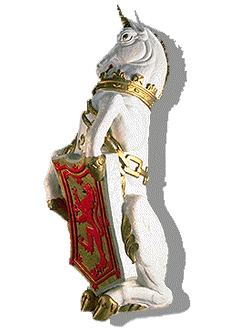
![]()
The Queen's Beasts: The Unicorn of Scotland

CMC 980.9.2
From the time of earliest human civilization, depictions of certain animals — real or imaginary — were used as symbols of royalty and power. Such "beasts" were among the earliest icons used in medieval heraldry. The Tudor monarch, Henry VIII (1509-1547), commissioned carvings of those beasts most closely associated with British royalty, to decorate his palace at Hampton Court. These were the inspiration for the human-size Queen's Beasts sculpted in plaster to guard Elizabeth II's entrance into Westminster Abbey at her Coronation in 1953.
The fabled unicorn was known in ancient Mesopotamia, India, China and later in the Christian West. It was a symbol of fierceness, strength, and purity. The only way to catch it was to trick it to come to a maiden. By the fifteenth century it had become part of the heraldic menagerie of the Scottish kings and, when James VI of Scotland succeeded Elizabeth I to the throne of England in 1603, thereafter the Scottish unicorn and the English lion became the heraldic supporters of the Royal Arms of the United Kingdom.
